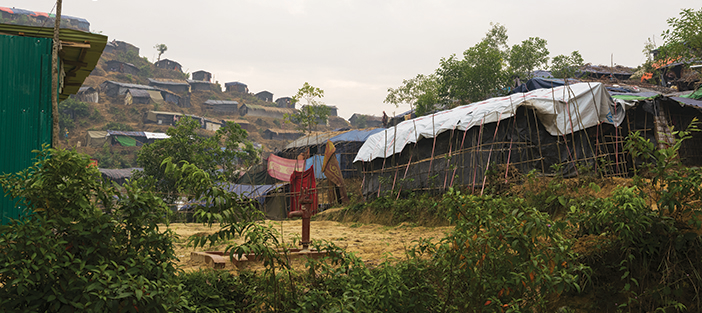Volunteers work to stem the tide of TB among the Rohingya.
It was mid-morning when the bus slowed down. An attendant began yelling, noting the stop. Outside the bus, the rice fields dotted with water buffalo and tufts of bamboo had given way to a market that encroached upon and overtook the road. A symphony of activity surrounded us, with brightly bedizened rickshaws swerving from one side of the pavement to another. Sellers hawked mangoes, onions, bananas, and greens—albeit with an air of mid-Ramadan indifference.
“Kutupalong bazaar! Kutupalong bazaar,” the bus attendant shouted.
I disembarked into the surrounding cacophony. Just behind the market was the Kutupalong Rohingya refugee camp. I had come to southern Bangladesh to study tuberculosis treatment efficacy within Kutupalong and Balukhali, another large Rohingya camp, where HAEFA, founded by my mentor Ruhul Abid, MD, PhD, has been serving since the beginning of the most recent exodus of refugees in 2017. Saim Khan, the project coordinator for Health and Education for All (HAEFA) and my unfailing guide, took me on a rickshaw into the camp to our health clinic
Since October 2017, HAEFA has provided free medical care to more than 55,000 Rohingya patients with special emphasis on chronic diseases like hypertension, diabetes, anemia, and asthma, which are difficult to manage without systematic health care delivery and record-keeping systems. HAEFA’s innovative solar-powered electronic medical record system, known as NIROG, has enabled HAEFA to follow chronic cases using a longitudinal patient tracking system (see Brown Medicine, Winter 2018). In addition to providing sustained care for chronic diseases, HAEFA has been using NIROG to refer and track TB and high-risk pregnancies to specialized care centers in the camps
MOMENTS OF DOUBT
Once inside the Kutupalong camp, I felt small; my research ideas felt insignificant. Even my humanitarian optimism that had served me thus far in life seemed dampened by the monsoon mud that covered everything around me. I was most struck by the density, scale, and chaos of the camp. Saim took me up to a ridgeline and I followed the sheen of corrugated metal mixed with orange-and-white UNHCR (United Nations High Commissioner for Refugees) tarps as they stretched to the horizon in every direction. In front of us, most immediately, was a makeshift graveyard on a hillside—a sober reminder that there can be permanence in the struggle as refugees
As we walked on the mud and brick paths from one camp sector to another, we used most of our energy to dodge bikes, people, vans, cars, trucks, and minibuses. At times it felt one could not move in all the congestion. Nothing seemed static. Everyone and everything moved, constantly. I could not help but feel the persistent state of flux that the camp residents must experience so deeply.
In that moment, my crisis of self-doubt deepened. How could we possibly produce anything of any impact for the roughly one million people who surrounded us? How profoundly hubristic were we to think that we had something to offer? Yet over the course of the following month, I grew a sense of perspective. During our last week, Dr. Abid and I worked intensely to track the patients with TB and visited several health centers that provided treatment to TB patients who, due to landslides, have had to continuously move from one place to another. We saw the efforts of thousands of others (most of them Bangladeshi and Rohingya nationals) come together to form a tapestry of care, nourishment, and safety for the residents of the camps. By no means are these efforts perfect, but we came to see that our work there was its own small piece that could contribute to the greater collective effort
TRACKING TB
In that month, we worked with incredibly motivated and caring professionals. We spent most of our time collecting tuberculosis patient data. Given the documented difficulty in treating TB, we wanted to know how well treatment was being administered. Were patients receiving the required doses every day? Were they receiving treatment for the correct amount of time?
It appeared that none of the patients we studied had finished the full course of treatment, which may put the patients at risk to develop drug-resistant TB. Given all the challenges and limited resources, approximately two-thirds of the cohort progressed from the two-month intensive four-drug treatment phase to the continuation two-drug phase for the next four months. Despite the truncated treatment courses, it was encouraging to find that the majority of the patients took medicines for more than four months even in such chaotic conditions. In order to improve efficacy, we have proposed to provide NIROG to the TB health centers for better follow up of their patients.
Through our collective experiences and efforts, we found that while imperfect, the humanitarian response for the Rohingya people in southern Bangladesh persists as a direct result of those who put in the effort. Every organization and every dedicated displaced person there deserves the accolades for any advancement in the collective humanity of those camps. We volunteers should always remain tangential figures, helping to facilitate and shine light not only on the pressing issues but on the hard-fought successes for and by the Rohingya people.
Jason Tsichlis is a Returned Peace Corps Volunteer (Burkina Faso, 2011-2013) with a master’s degree in international agricultural
development from UC Davis. Prior to medical school, he worked on nutrition and climate sensitive agriculture, community health, and agricultural vocational educational education in West Africa.
Ruhul Abid is an associate professor of surgery and the founder of HAEFA, a US-based 501(c)(3) nonprofit humanitarian organization. HAEFA is supported by individual donor contributions, which can be made at www.haefa.org.




